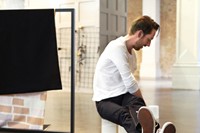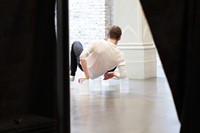Claire Barclay’s installation, Shadow Spans has been at the Whitechapel Gallery since last May. A couple of weeks ago, dancer Matthias Sperling joined the installation space with a series of plastic pots, which he uses to support his arms, legs and
Claire Barclay’s installation, Shadow Spans has been at the Whitechapel Gallery since last May. A couple of weeks ago, dancer Matthias Sperling joined the installation space with a series of plastic pots, which he uses to support his arms, legs and torso while moving around the installation – for hours on end. The piece, To hand, blurs the line between contemporary dance and performance art, and is a collaboration between Sperling and choreographer Siobhan Davies. Deep concentration, repetition and humour are all central to Sperling’s performance, which one viewer described as “writing choreography as it happens.” AnOther caught up with Davies and Sperling during a busy Q&A session at the gallery.
What was your starting point?
Siobhan Davies: I'm curious about bringing movement into a gallery space, rather than somewhere more aligned to theatre. Two years ago Matthias and I were involved with a piece called Minutes, at the Victoria Miro gallery, for which Anri Sala devised a work in response to what we were doing. With this it’s the other way around – we’re responding to Claire’s work.
How does the gallery context influence the nature of the piece?
Matthias Sperling: One thing is it allows people to encounter movement at a much closer proximity than they would at a theatre. I wouldn't expect to do what I'm doing here onstage for an hour; I would feel pressure to have lots of different ideas over that period of time. This context allows me to focus on doing one thing.
SD: Also, we were very aware the audience would be visiting on gallery terms. They turn up whenever they want, and some people march through on their way to another part of the gallery, while others stay for an hour and a half. Because of this, we wanted to ensure that Matthias was constantly at work and concentrating on the task he's given himself. There isn't a second when he isn't applying thought and movement.
The piece is obviously about movement, but there are moments of stillness as well; what one person described as you locked in Henry Moore poses.
MS: I think it’s fantastic to have a relevance to sculpture, but I also want to avoid the perspective of the ‘dancer as an object’. I'm interested in the dynamic that’s created between the viewer as a subject and the performer as a subject, and how that's different to the viewer’s relationship with an object.
There’s also a certain amount of absurdity inherent in the piece; the plastic pots, the repetitive nature of your task…
MS: We really wanted it to have lightness. Siobhan and I are interested in working in ways to produce something strong and articulate, but without taking ourselves too seriously – which is becoming more frequent in contemporary dance, but in my experience, is a relatively recent phenomenon.
What sorts of audience reactions have you had?
SD: Somebody said they think the audience is aware there’s an element of danger, and that mistakes seem inevitable, so they’re rooting for Matthias. There's a real tension between people happily watching him so absorbed in what he’s doing, but also wondering what will happen if it goes wrong. He’s also had children steal a few of his pots, and he’s been offered sweets, which he declined.
To hand is in its last week at the Whitechapel Gallery. Watch Sperling at his pots from 1 – 5:30pm, Wednesday – Sunday, except Thursdays 4 – 8pm, until 20 March.
Text by Ananda Pellerin
Ananda Pellerin is a London-based writer and the editor of Wheel Me Out.


